Analysis of Embankment Temperature Regulation Efficiency of V-Shaped Bidirectional Heat Conduction Thermosyphon in Permafrost Regions
Abstract
1. Introduction
2. V-Shaped Bidirectional Heat Conduction Thermosyphon
3. Heat-Moisture-Deformation Coupling Model
3.1. Geometric Model and Material Parameters
3.2. Governing Equation
3.3. Model Verification
4. Analysis of Temperature Regulation Efficiency
4.1. Cross-Section Temperature Field Analysis
4.2. Depth Temperature Field Analysis
4.3. Long-Term Temperature Field Analysis
4.4. Analysis of Slope Foot Temperature Field
4.5. Analysis of Regional Temperature Field
5. Conclusions and Prospect
- (1)
- Innovatively put forward the V-shaped transverse through the tiled bidirectional heat conduction type thermal rod (V-shaped bidirectional heat conduction type thermosyphon), to ensure the uniform distribution of the temperature field of the whole section of the subgrade, to make up for the traditional thermosyphon temperature control range, which is limited. This work contributes to the sustainable development of infrastructure in permafrost regions by offering a more reliable and efficient temperature regulation solution.
- (2)
- Based on the COMSOL (6.2 version) numerical platform, the hydro-thermal coupling analysis model of permafrost embankment is established, and the effective prediction and rapid simulation of the permafrost embankment temperature field are realized. Such a model helps optimize the design of temperature regulation systems for embankments, reducing energy consumption and environmental impact, and thus supports the sustainable development of infrastructure in permafrost regions.
- (3)
- The numerical analysis shows that the bidirectional heat conduction thermosyphon has significant advantages in controlling the subgrade cross-sectional temperature field, depth temperature field, and long-term temperature field. Its temperature control stability, uniformity, and temperature fluctuations are superior to those of direct-inserted and oblique-inserted thermosyphons.
- (4)
- At the foot of the embankment slope, the temperature regulation effect of the bidirectional heat conduction thermosyphon is consistent with the performance of the direct-inserted thermosyphon and oblique-inserted thermosyphon.
- (5)
- In the seasonal frozen soil area, the temperature regulation effect of the bidirectional heat conduction thermosyphon is significantly better than that of the direct-inserted thermosyphon and oblique-inserted thermosyphon. This indicates that the bidirectional heat conduction thermosyphon has better adaptability to different climate conditions, which is crucial for the sustainable development of infrastructure in cold regions.
- (1)
- Although the V-shaped design shows advantages in temperature regulation, further optimization of its geometric parameters (such as the angle of the thermosyphon) could potentially enhance its performance.
- (2)
- Investigating new materials with higher thermal conductivity and better durability for thermosyphons could improve their efficiency and lifespan.
Author Contributions
Funding
Institutional Review Board Statement
Informed Consent Statement
Data Availability Statement
Conflicts of Interest
References
- Wei, Y.; Xue, X. Exploration of the stability of slope embankment in permafrost regions. J. Railw. Eng. 2011, 28, 35–39. [Google Scholar]
- Gao, F.; Zeng, X.; Zhong, W.; Huang, S.; Zhang, J. Research Progress and Prospect of Road Engineering Disease Treatment Technology in Permafrost Regions. Chin. Foreign Highw. 2024, 44, 1–16. [Google Scholar]
- Wang, S.; Chen, J.; Jin, L.; Dong, Y. Research Progress and Prospect of Scale Effect Theory of Frozen Soil Subgrade. Ind. Build. 2023, 53, 45–53. [Google Scholar]
- Peng, H.; Chen, J.; Wang, Z.; Ma, W.; Mu, Y. Heat affected zone of road engineering in permafrost region of Qinghai-Tibet Plateau. China J. Highw. 2015, 28, 92–99. [Google Scholar]
- Qin, X.; Cui, K.; Qing, Y. Rainfall infiltration law and infiltration mechanism of seasonal frozen soil slope under hydrothermal coupling. China Highw. J. 2022, 35, 12. [Google Scholar]
- Hong, W.; Xu, X.; Yu, H. Groundwater seepage model test of slope in seasonal frozen area. Sci. Technol. Eng. 2017, 17, 9. [Google Scholar]
- Tong, R.; Song, E.; Zhao, Z. Measurement of frost heave process of a railway subgrade and analysis of “time-varying coverage effect”. J. Railw. Sci. Eng. 2020, 17, 8. [Google Scholar]
- Smith, L.B.; Graham, J.P.; Nixon, J.F.; Washuta, A.S. Thermal analysis of force air and thermosyphon cooling system for the inuvik airport expansion. Can. Geotech. J. 1991, 28, 399–409. [Google Scholar] [CrossRef]
- Sun, W.; Wu, Y.; Guo, C.; Zhang, L. Effects of hot rod on the stability of permafrost subgrade. China J. Highw. 2009, 22, 15–20. [Google Scholar]
- Wang, S.; Chen, J.; Jin, L.; Dong, Y.; Chen, D. Theoretical study on highway design in permafrost regions based on energy balance. Glaciol. Permafr. 2014, 36, 782–789. [Google Scholar]
- Li, Y.; Wu, Z.; Wang, Y. Experimental study on the application effect of hot rod on permafrost subgrade of Qinghai-Tibet Railway. China Railw. Sci. 2008, 29, 6–11. [Google Scholar]
- Liu, G.; Wang, S.; Jin, L.; Dong, Y.; Yuan, K. Application effect of hot rod subgrade in permafrost regions. Transp. Eng. J. 2016, 16, 59–67. [Google Scholar]
- Sheng, Y.; Wen, Z.; Ma, W.; Wu, J. Three-dimensional nonlinear analysis of temperature field of hot rod subgrade in permafrost region of Qinghai-Tibet Railway. Railw. J. 2006, 28, 125–130. [Google Scholar]
- Zhang, J. Study on Design Technology of Highway Subgrade in Permafrost Regions; Graduate School of Chinese Academy of Sciences: Beijing, China, 2008. [Google Scholar]
- Feng, G. Past, present and future of permafrost subgrade engineering research in China. Glaciol. Permafr. 2009, 31, 139–147. [Google Scholar]
- Wang, L.; Li, G.; Chen, Y. Design and calculation method of thermosyphon subgrade in permafrost regions based on the principle of heat budget balance. Geotech. Mech. 2020, 41, 529–536. [Google Scholar]
- Jin, L.; Wang, S.; Mu, K.; Peng, H. Cooling efficiency of hot rod subgrade of Qinghai-Tibet Highway. Glaciol. Permafr. 2016, 38, 529–536. [Google Scholar]
- Xu, J.F.; Goering, D.J. Experimental validation of passive permafrost cooling systems. Cold Reg. Sci. Technol. 2008, 53, 283–297. [Google Scholar] [CrossRef]
- Sun, Z.Z.; Ma, W.; Li, D.Q. In situ test on cooling effectiveness of air convection embankment with crushed rock slope protection in permafrost regions. J. Cold Reg. Eng. 2005, 19, 38–51. [Google Scholar]
- Sun, Z.K.; Wang, L.J.; Bai, M.Z.; Wei, Q.C. Finite element analysis of temperature field in permafrost embankment of Qinghai-Tibet Railway. J. Rock Mech. Eng. 2004, 23, 3454–3459. [Google Scholar]
- Wang, F. Numerical Simulation and Vibration Characteristics Analysis of Environmental Vibration of High-Speed Railway Based on ABAQUS; Beijing Jiaotong University: Beijing, China, 2014. [Google Scholar]
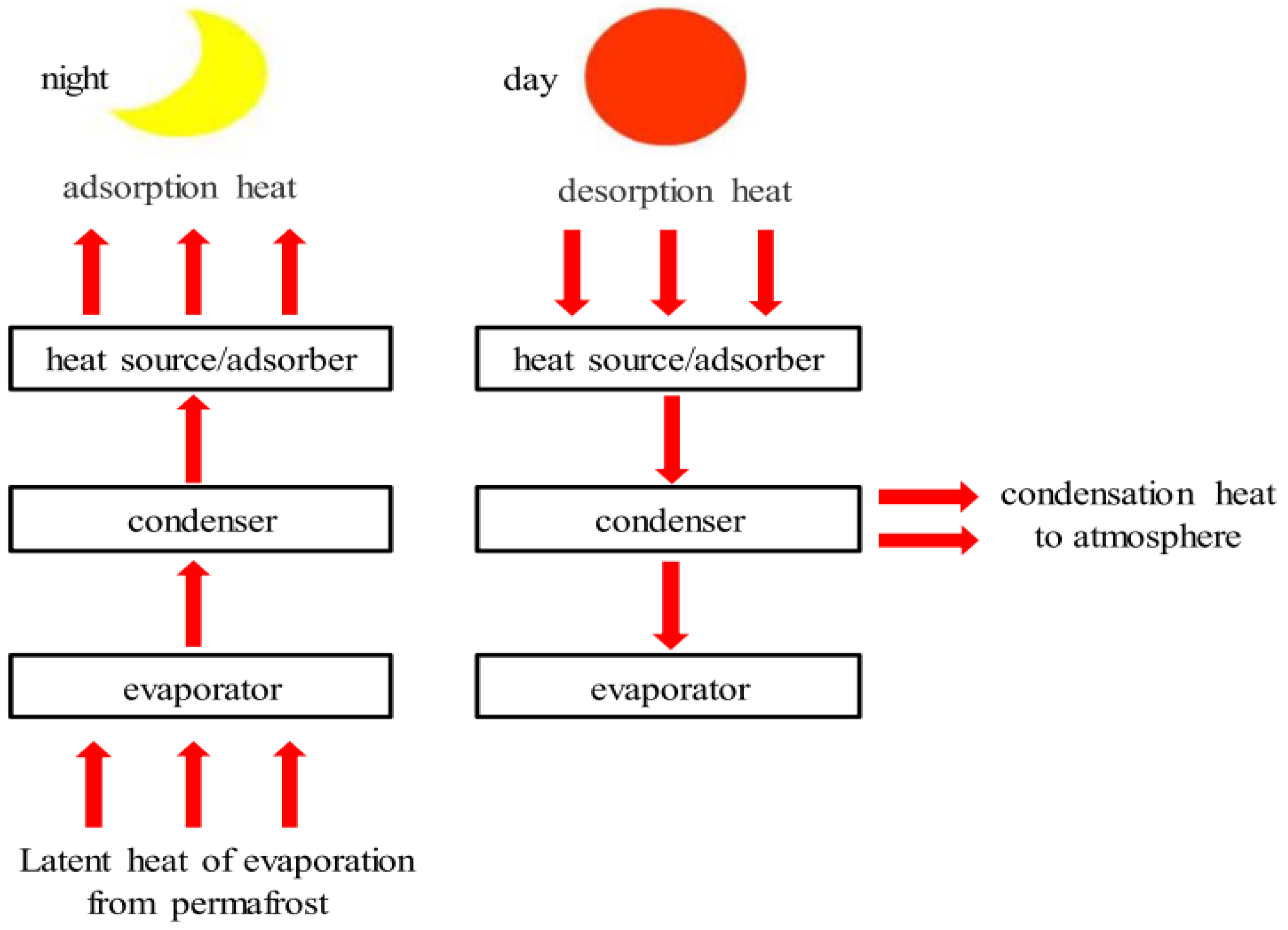

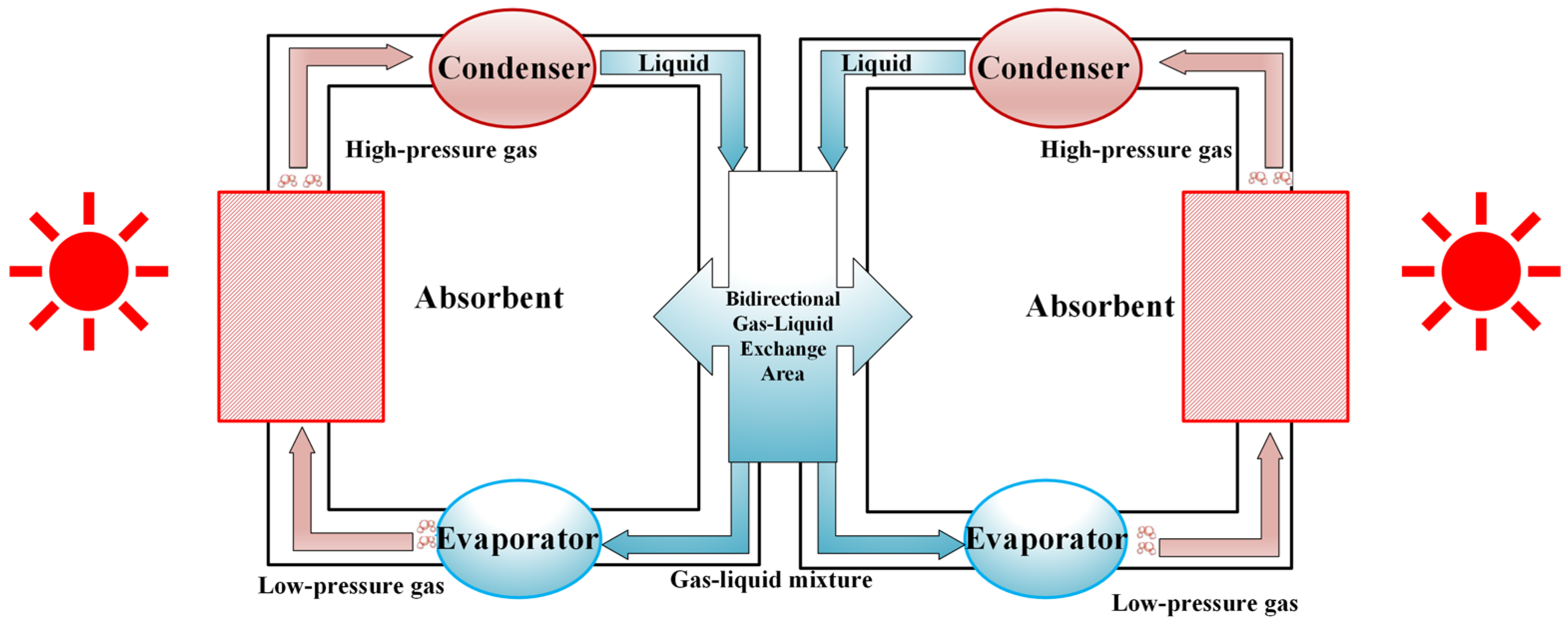
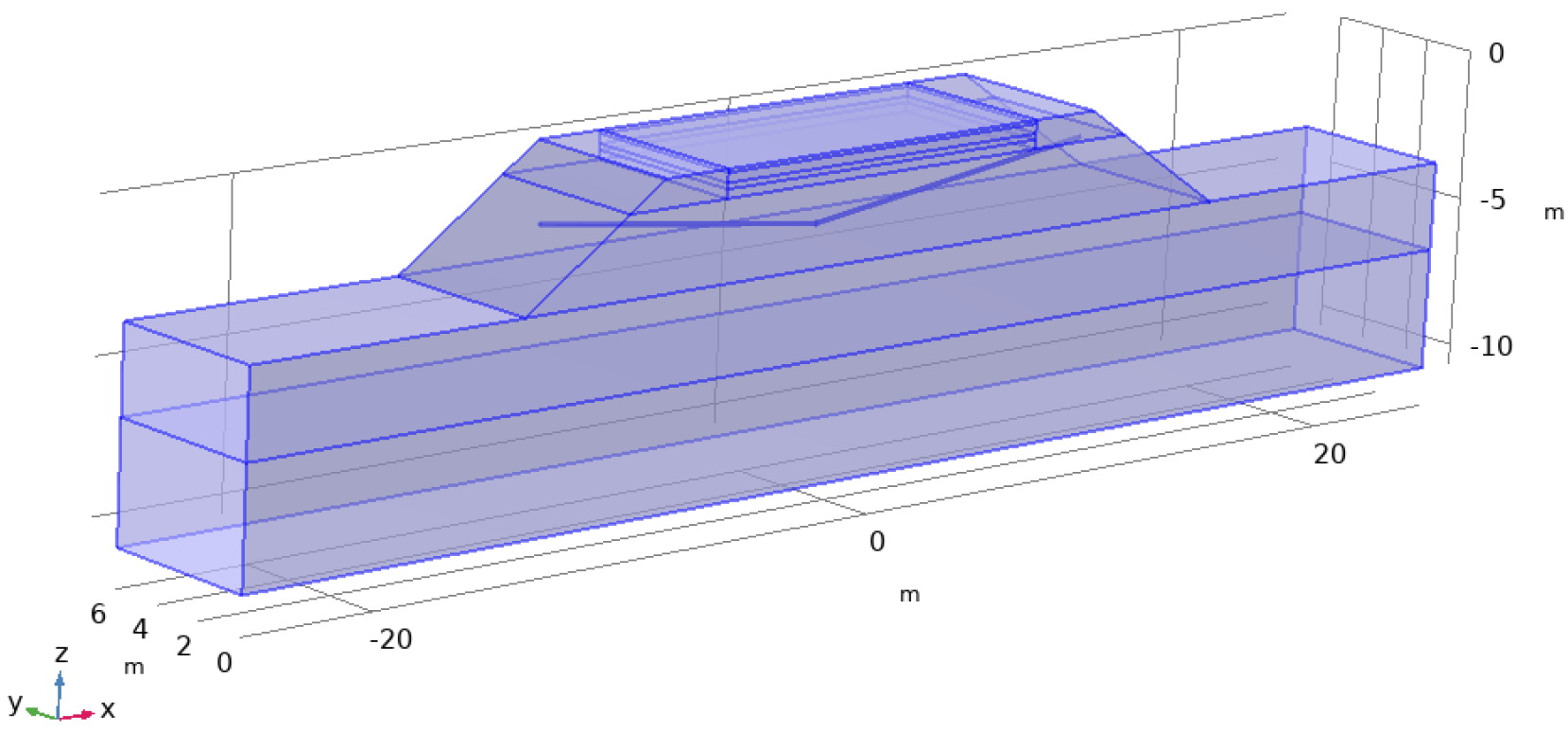
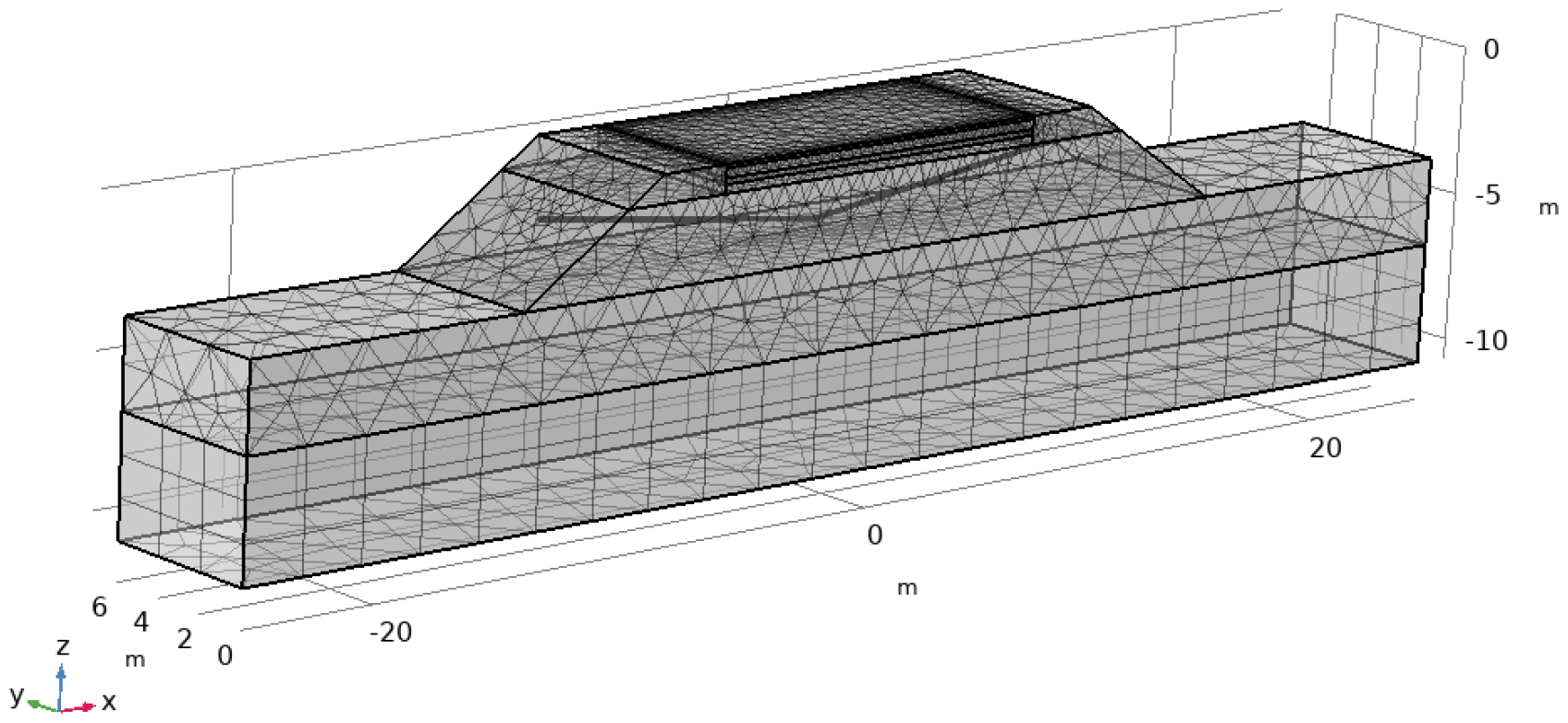
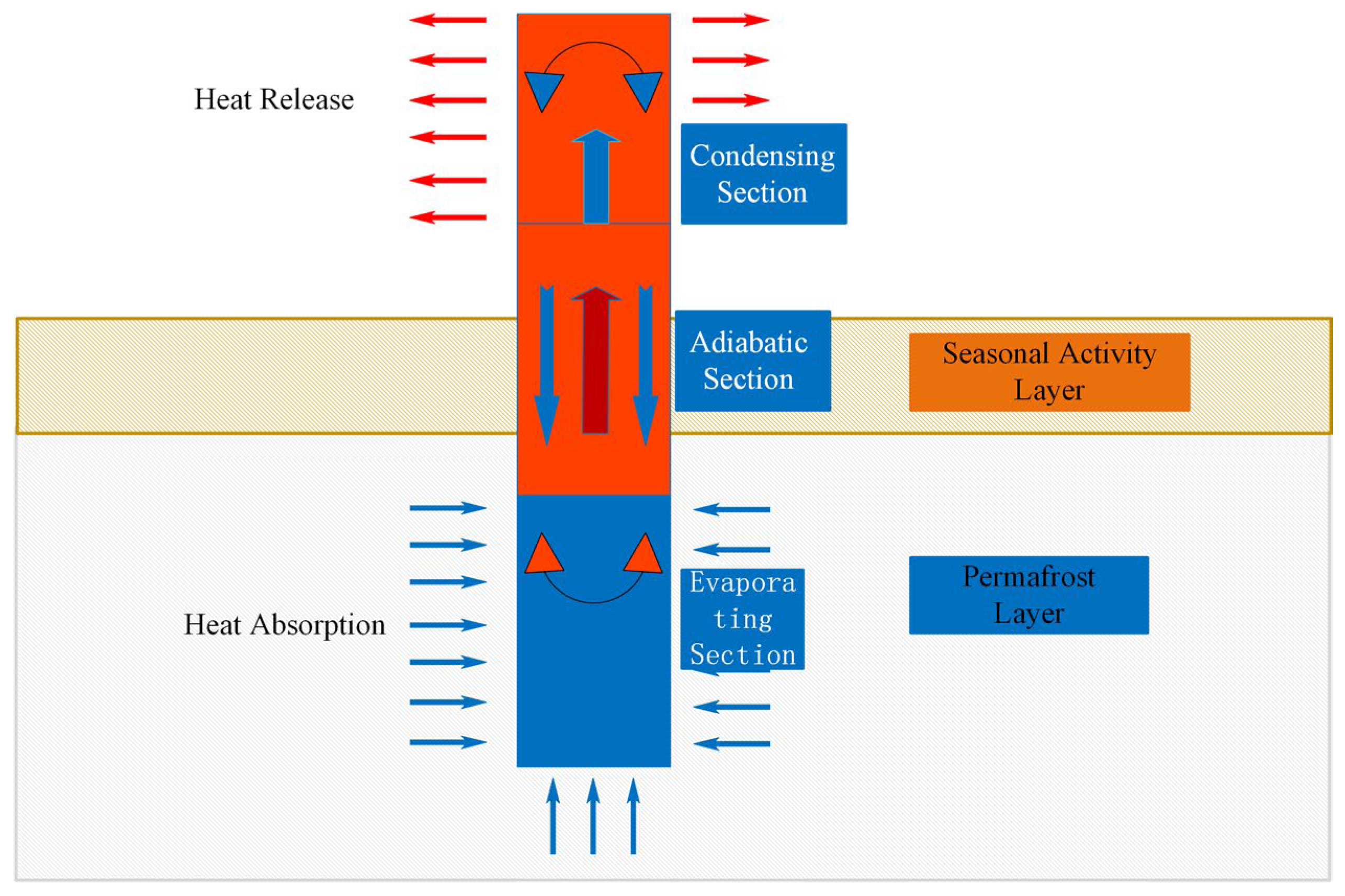


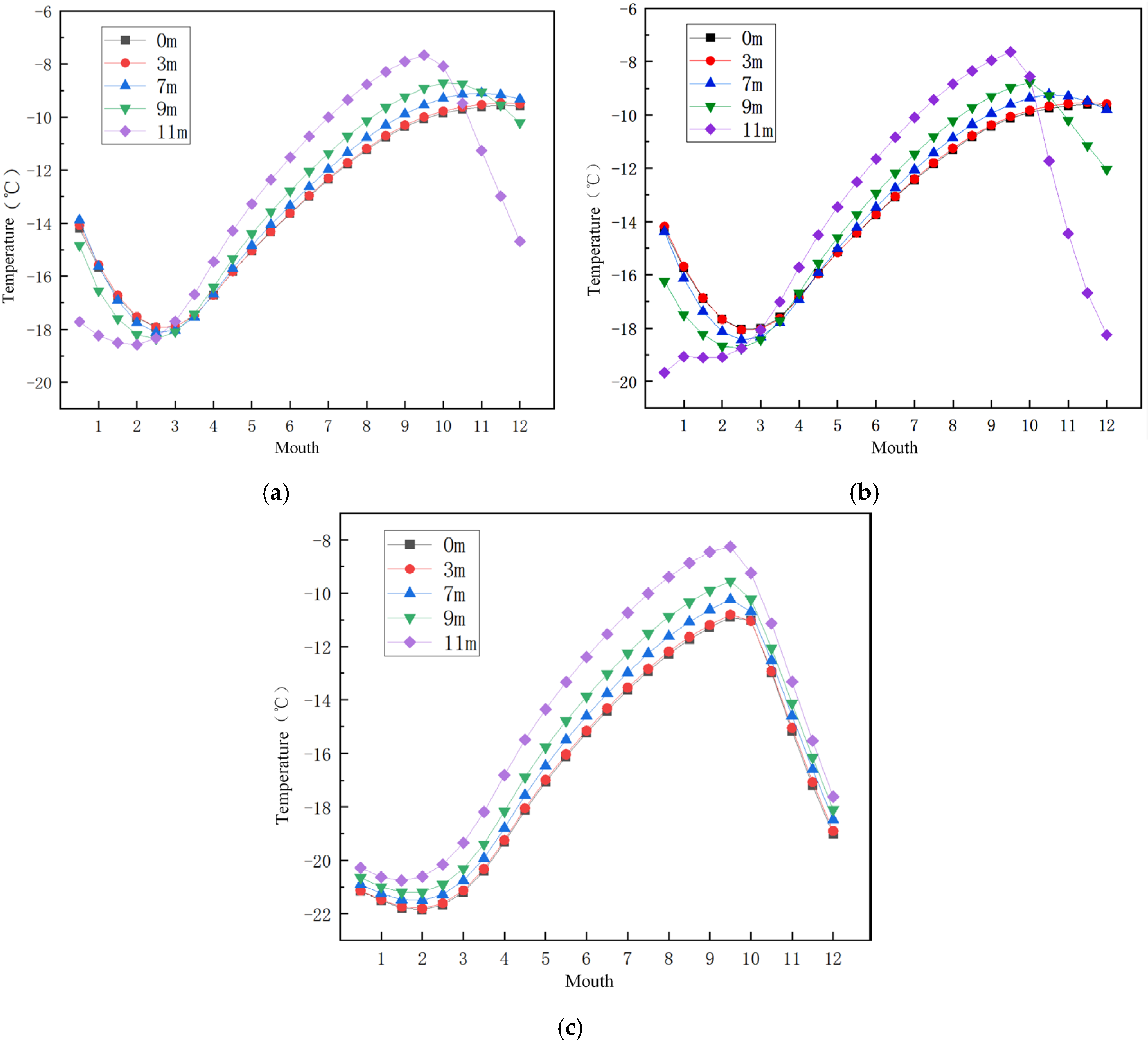


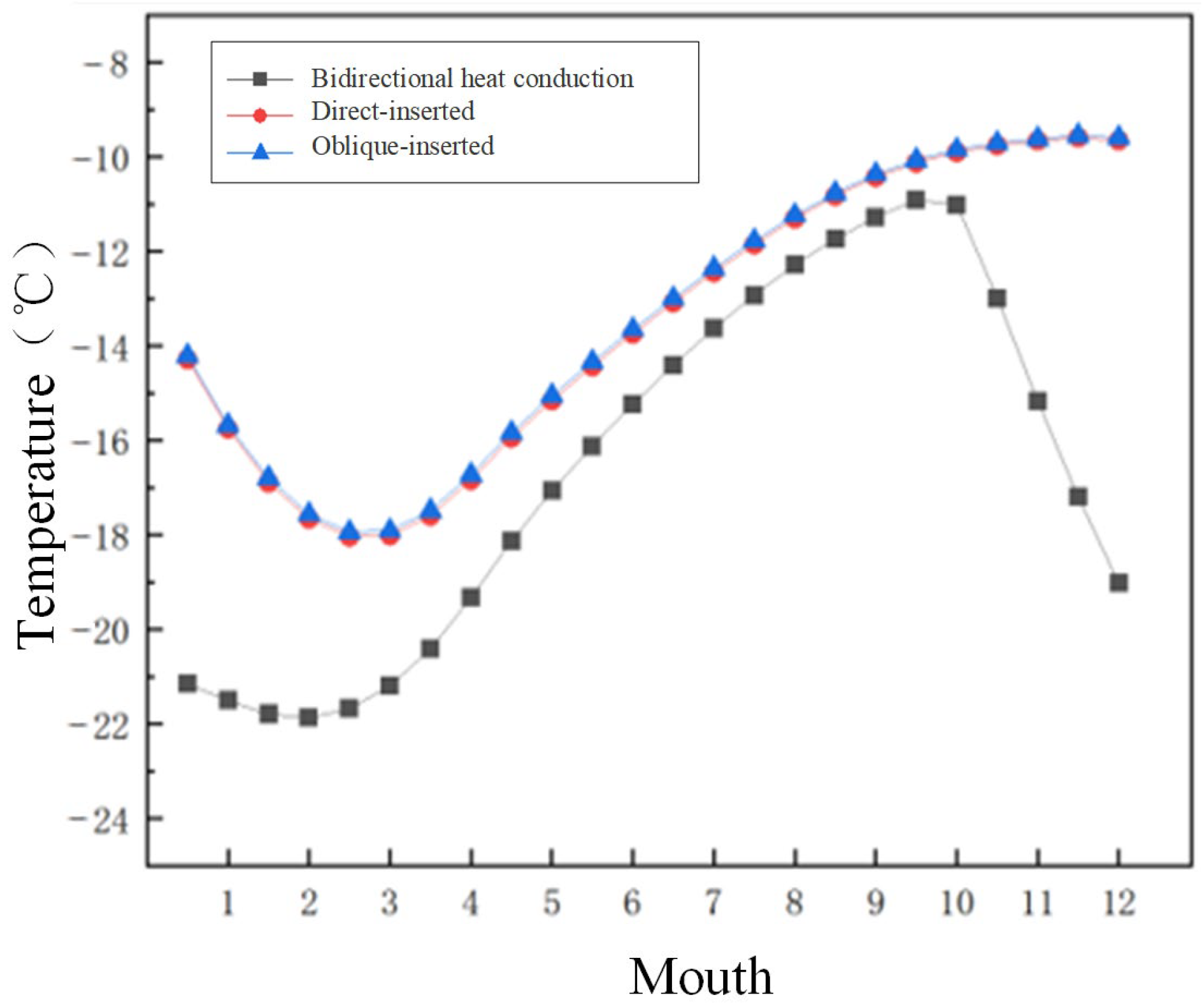
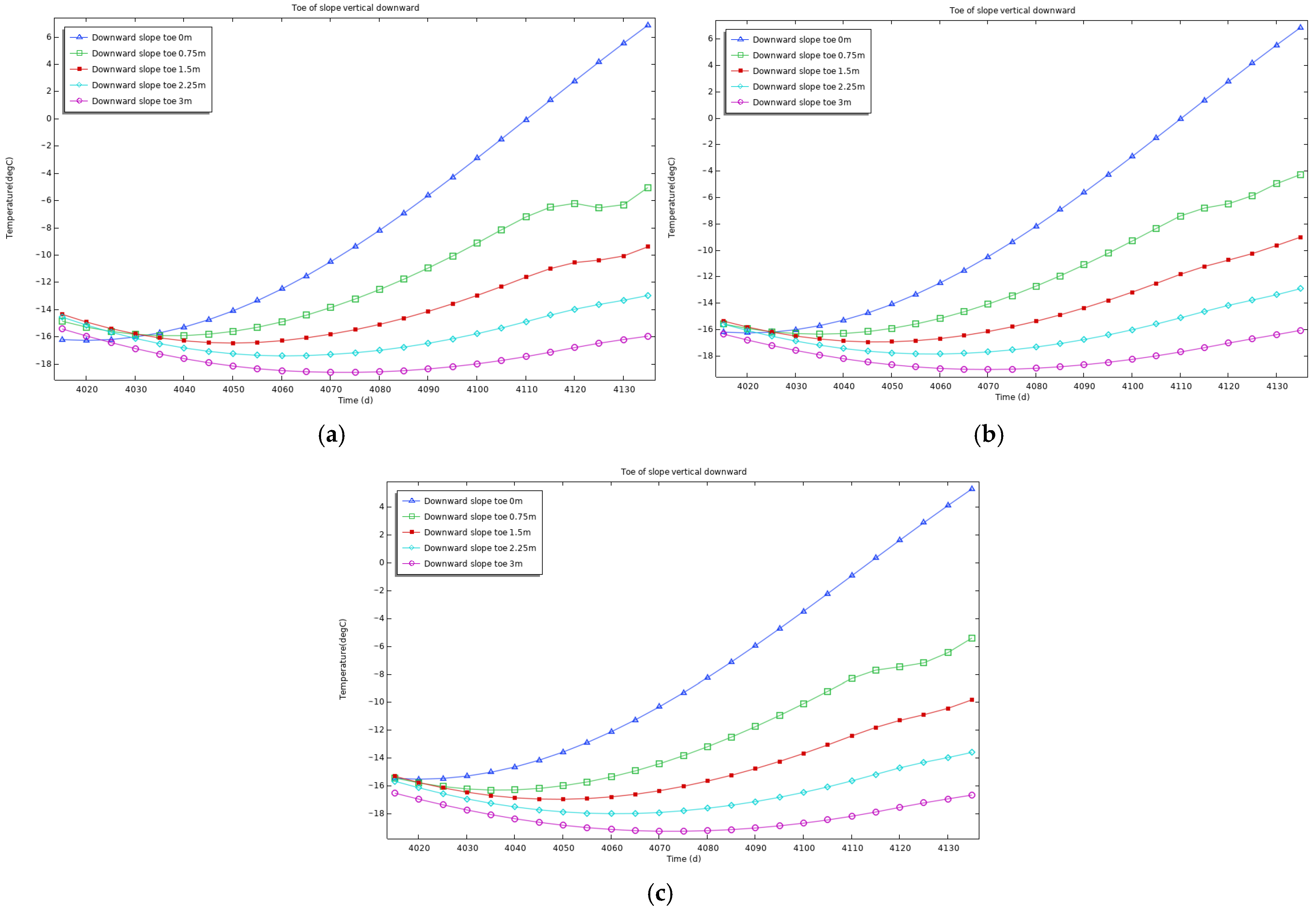

| Horizon | Material | Density (kg/cm3) | Water Content (%) | |
|---|---|---|---|---|
| ρ | w | |||
| Pavement | Medium-grain asphalt concrete | 2200 | - | |
| Foundation course | 4.5% cement stabilized gravel | 2000 | - | |
| Subgrade | Roadbed soil | 1800 | 15 | |
| Clay | Clay | 1500 | 30 | |
| Bed rock | Weathered sandstone | 2000 | 2 | |
| Horizon | Thermal Conductivity (W·m−1· °C−1) | Specific Heat Capacity (J·kg−1· °C−1) | ||
| λu | λf | Cu | Cf | |
| Pavement | 1.68 | 1.68 | 1120 | 1120 |
| Foundation course | 1.57 | 1.57 | 900 | 900 |
| Subgrade | 1.82 | 1.98 | 1463 | 1129 |
| Clay | 1.24 | 1.89 | 2090 | 1588 |
| Bed rock | 1.51 | 1.69 | 877 | 771 |
| Temperature | Reynolds Number | Prandtl Number | Nusselt Number |
|---|---|---|---|
| T | Rea | Pra | Nua |
| °C | 1 | 1 | 1 |
| −40 | 33888 | 0.728 | 167.13 |
| −30 | 31466 | 0.723 | 158.54 |
| −20 | 29277 | 0.716 | 150.45 |
| −10 | 27322 | 0.712 | 143.27 |
| 0 | 25559 | 0.707 | 136.58 |
| Temperature | Coefficient of Convective Heat Transfer | Heat Exchange Area | Effective Heat Transfer Coefficient |
| T | α | F | αe |
| °C | W/(m·°C) | m2 | W/(m·°C) |
| −40 | 35.38 | 3.913 | 29.67 |
| −30 | 34.84 | 3.886 | 29.29 |
| −20 | 34.28 | 3.858 | 28.89 |
| −10 | 33.81 | 3.834 | 28.55 |
| 0 | 33.35 | 3.81 | 28.23 |
| Depth from Orifice/m | Measured Value/°C | Calculated Value/°C | Error/% |
|---|---|---|---|
| 0 | −15.8 | −15.53 | 0.44 |
| −2 | −2.0 | −2.14 | 7.00 |
| −3 | −3.4 | −3.40 | 0.00 |
| −3.5 | −3.6 | −3.76 | 4.44 |
| −4 | −3.0 | −3.18 | 6.00 |
| −4.5 | −3.1 | −3.04 | 1.94 |
| −5 | −2.5 | −2.71 | 8.40 |
| −6 | −2.6 | −2.49 | 4.23 |
| −7 | −2.5 | −2.27 | 9.20 |
Disclaimer/Publisher’s Note: The statements, opinions and data contained in all publications are solely those of the individual author(s) and contributor(s) and not of MDPI and/or the editor(s). MDPI and/or the editor(s) disclaim responsibility for any injury to people or property resulting from any ideas, methods, instructions or products referred to in the content. |
© 2025 by the authors. Licensee MDPI, Basel, Switzerland. This article is an open access article distributed under the terms and conditions of the Creative Commons Attribution (CC BY) license (https://creativecommons.org/licenses/by/4.0/).
Share and Cite
Duan, F.; Tian, B.; Hu, S.; Quan, L. Analysis of Embankment Temperature Regulation Efficiency of V-Shaped Bidirectional Heat Conduction Thermosyphon in Permafrost Regions. Sustainability 2025, 17, 6048. https://doi.org/10.3390/su17136048
Duan F, Tian B, Hu S, Quan L. Analysis of Embankment Temperature Regulation Efficiency of V-Shaped Bidirectional Heat Conduction Thermosyphon in Permafrost Regions. Sustainability. 2025; 17(13):6048. https://doi.org/10.3390/su17136048
Chicago/Turabian StyleDuan, Feike, Bo Tian, Sen Hu, and Lei Quan. 2025. "Analysis of Embankment Temperature Regulation Efficiency of V-Shaped Bidirectional Heat Conduction Thermosyphon in Permafrost Regions" Sustainability 17, no. 13: 6048. https://doi.org/10.3390/su17136048
APA StyleDuan, F., Tian, B., Hu, S., & Quan, L. (2025). Analysis of Embankment Temperature Regulation Efficiency of V-Shaped Bidirectional Heat Conduction Thermosyphon in Permafrost Regions. Sustainability, 17(13), 6048. https://doi.org/10.3390/su17136048








